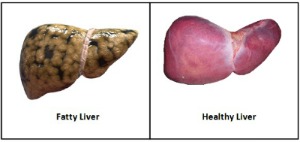WHAT DOES YOUR LIVER DO?
WHAT IS “FATTY LIVER”?
Fatty Liver refers to a condition where fat cells are deposited in your liver. The fat cells come from things like your diet, alcohol, and cholesterol. If you get too much fat in your liver, it can be harmful. It can cause damage by scarring, inflammation, and cirrhosis.
Most of the time, you will not have any symptoms from a fatty liver. Symptoms do not appear until your liver is very damaged (in the later stages of fatty liver disease).
Your doctor may discover signs of fatty liver through routine blood tests. Sometimes, fatty liver is found by accident (“coincidentally”) by an ultrasound of your belly that was ordered for some other reason.
ALCOHOL:
Drinking too much alcohol is common cause for having a fatty liver. If you drink more than the following, it can be harmful for your health:
- 14 drinks per week for males
- 7 drinks per week for females
If you have been told you have fatty liver disease, you should try to drink even less than that. Ideally, you should drink as little alcohol as possible.
NON-ALCOHOLIC FATTY LIVER DISEASE:
People can have fatty liver disease for reasons other than alcohol. This is called “Non-Alcoholic Fatty Liver Disease” (NAFLD). This is becoming a very common disease in North America due to increased rates of obesity, diabetes, poor diet, and lack of exercise.
For even more information on Fatty Liver Disease, be sure to visit the Canadian Liver Foundation’s website.
HOW DO YOU TREAT OR PREVENT FATTY LIVER DISEASE?
There are not many proven ways to treat fatty liver disease. The main treatments are simple, but sometimes hard for people:
- Try to stop drinking alcohol, or at least cut back to the recommended amounts shown above.
- Besides limiting alcohol, LOSING WEIGHT is the absolute best way to treat fatty liver disease. Click here for more information on losing weight.
- Eat a balanced and healthy diet.
- Exercise and maintain an active lifestyle.
- Some research has shown that taking Vitamin E (800 units per day) can help. Vitamin E can be purchased “over-the-counter” and is not a prescription medication.
